What is wart? We will analyze the causes of occurrence, diagnosis and methods of treatment in an article by a dermatologist with 37 years of experience.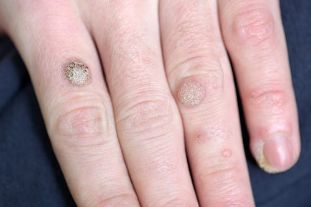
disease definition. Causes of illness
Warts <> Warts are irregularly flared benign skin lesions in the form of papules (nodules) or plaques in the upper part of the upper layer of the skin (epidermis).
The incidence of warts in adults is 7–12%, in school-age children - up to 10–20%.
Warts are similar to other skin growths. Usually, a person cannot accurately determine the disease on their own, so a dermatologist should be consulted for diagnosis.< / p>
HumanPapillomavirus is the cause of warts. The type of virus affects the type of warts that can develop. Thus, each type of human papillomavirus infects tissue upon localization which is its most characteristic.
| HPV type | preferred localization |
warts type |
|---|---|---|
| 1 | feet, knees, palms, hands, fingers |
Plantar and Palmer warts, rarely simple warts |
| 2, 4 | hands, fingers, knees, less often - feet |
simple warts, sometimes basement, palmar and mosaic warts |
| 3, 10 | Shins, hands, face | flat warts |
| 7 | hands, fingers | butcher's warts |
| 5, 8, 9, 12, 14, 15, 17, 19-24 | face, hands, front torso |
epidermodysplasia virtuiform |
Virus infection usually occurs through contact - with direct contact between infected and healthy skin (for example, when shaking hands) or indirectly (through handrails, toys, etc. ). , You can get infected with human papillomavirus, which causes warts, in a wide variety of places - in public transport, at school, at work, at home, in high exposure and moist environments (swimming pools, saunas, gyms). Also, minor trauma to the epidermis, through which viruses enter, as well as skin inflammation, contributes to infection. <> / p>
Also contributed to the presence of warts:
- immunodeficiency (including HIV infection);
- hot and humid environment;
- Need for professional contact with meat and fish ("butcher's warts").
Some types of human papillomavirus are transmitted from parents.
But Toad and the Frog, despite the horror stories with which we are often frightened in childhood, cannot be infected - this is one of the most popular myths about the disease, which has no basis.
If you get similar symptoms, consult your doctor. Do not self-medicate - it is dangerous for your health!
wart symptoms
Symptoms will vary depending on the type of wart.
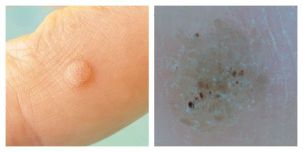
common wart:
- A dense crust of normal color, 1-10 mm and larger.
- The surface of the papule is covered with cracks, layers.
- If there is papule on the finger, the print disappears and is distorted. The same goes for palm drawing.< / lix >
- Simple warts are located either alone or in multiple pieces - theyUsually appear in places of greatest injury (hands, fingers, knees).
- When viewed with a dermatoscope, the doctor may see small brown dots - thrombosed (filled) capillaries. The patient often refers to these points as "original". This is what a doctor would do for a doctor. The main indication is: It can be used by a dermatologist to differentiate a wart from other similar diseases (eg, molluscum contagiosum and keratoma).
plantar (horned) wart:
- The main symptom that a patient usually has to see is pain when pressing and walking.
- Such warts are usually localized on the feet.
- When going to a doctor, as a rule, a keratinous uneven plaque of normal color appears, although in the first stage you may see a uniform, smooth papule. With keratinization, capillaries are only seen. Can occur when the keratinized layer of skin is removed. <> / l >.
- The skin of the sole is deformed.
- Plantar warts are usually solitary, but there are also 2–6 warts;
- These warts are often confused with corn (especially dried) - this is a description of the problem that patients come to see.
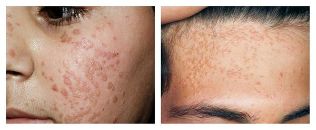
flat (teen) wart:
- It looks like a round, clear, smooth crust of normal, pink or brown color, 1-5 mm in size. .
- appears very often on the hands, calves, face.
- There are always many such warts - they are located in groups.
epidermodysplasia verruciform (cenilac wart):
- Large, round, normal, pink or brown with many confluent neoplasia.
- Most often appear in front of face, arms, torso.
- can be confused with keratoma, herpes and skin cancer.
wart pathogenesis
When it enters the body, the human papillomavirus can be in a latent state for a long time - a person is usually not even aware of its existence. When favorable factors appear for the virus, So it starts "multiplying" in the epithelium, causing tissue changes.< / p>
Unlike other viruses, the human papillomavirus does not self-destroy the cells of the epithelium - they die on their own. Are, naturally, in the process of keratinization and flaking.
Local factors and immune system status affect the spread of infection. For example, people with HIV infection or kidney transplant are more likely to develop warts. In addition, these neoplasms are often difficult to treat. With normal immunity, the virus does not affect the deeper layers of the skin, so many people get warts on their own after a few months.
The main stage in the presence of warts is the cell division with the help of the virus. Acceleration of rate and growth. This rapid metabolism thickens the layers of skin. As tissues grow over a fixed, small area, a tubercle appears, called a wart.
Classification and stage of wart development
is not a generally accepted classification of warts. However, there are several common varieties:
- common wart is the most common type (70% of warts are simply theirs). This type of neoplasm is not felt and only one person has aesthetic discomfort. .
- Plantar wart <> - appears on the soles of the feet, is painful, therefore requires treatment. Uncomfortable, tight, tight shoes cause skin trauma due to this. Contributes to the growth of warts.
- Flat warts <> - More often appear in young people, teenagers. This is due to the unstable hormonal background of young people, which affects the whole body. Usually flat warts are almost invisible. Occur.
- cunile warts- typical of the elderly. Often appear on the part of the body that is covered with clothing, but may occur on the face and hands ifIf there is no discomfort, such warts should not be treated - due to slow metabolism, treatment in older people may be much slower than in younger people.
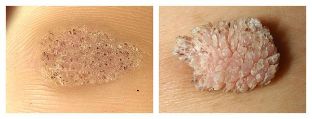
Other authors distinguish many more from this type of warts:
- mosaic warts <> (HPV 2, 4) - neoplasm on the palms and soles. They look like foci of hyperkeratosis, ie thickening of the striatum corneum (usually at the forefront). , Is covered with deep crevices.
- cystic warts(HPV 60) is a very rare type of neoplasm on the foot. It is a soft knot with cracks. Opening. However, a white-yellow discharge resembles curd.
- filiform warts <> There is a thin horn outbreak near the mouth, nose or eyes.
- "Butcher" warts <>(HPV7) - Appears on the hands and fingers of people who are in constant contact with meat and fish. Presented as hypertrophied neoplasm similar to cauliflower. Is done, but is of normal color.
Also, types of warts are distinguished by their location.
Thus, tumor-like impotence appearing on the genitals (especially in places where the skin passes into the mucous membrane), is a common disease. They are usually caused by HPV types 6 and 11.< / px >.
wart complications
The main reason for patients with warts to go to the doctor is an aesthetic defect that can affect a patient's quality of life, his or her confidence, and develop a lot of complexes. Breakdown of the wart surface in the complexesAnd infection can also involve joint, and in some types of warts, a sore throat while walking.
Skin warts do not usually fall into the malignant neoplasm, they are quite harmless, although, in very rare cases, such a complication may still occur in people with suppressed immune systems.
Other complications arise when attempting to remove the neoplasm on its own. In this regard, there may be swelling and aesthetic defects in the form of scars, as well as further spread of the virus through the skin, The reason is, in the morning after removing a wart, a person can wake up with many new people.
Remember that a completely different disease can be hidden under the cover of a wart, which someoneCan not be prescribed without the advice of an experienced doctor.
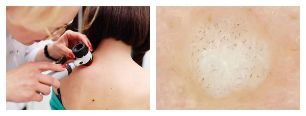
wart diagnosis
Usually, an examination (clinical picture) and anamnesis (medical history) are sufficient to make a diagnosis.
To confirm the diagnosis, doctors can perform a histological examination - studying the cells of the neoplasm.
To distinguish warts from other diseases - it is very important to make a differential diagnosis. For example,common warts <> should be distinguished from the following diseases:
- molluscum contagiosum- appears more frequently on the body and genitals, less often on the hands and feet. It is a hemisphere with an impression on the surface; When pressed from the sides, a white "gru" is released..
- epidermal verrucous nevus- often solitary, a person is born. Rises above the surface of the skin, often covered with hair.
- Basaloma- A tumor in the form of a roller of nodules, covered with a crust in the center. Typical for the elderly.< / lix >
Palmar-planar wartsshould be distinguished from the following diseases:
- keratoderma- large areas of skin keratinization and inflammation. no closed capillary.< / lix >
- palmar-plantar syphilids- Many painless neoplasm along the periphery, skin exfoliation. Syphilis has a positive reaction
- Corn- usually painless, can only be painful when erect.
The physician should distinguish several types of warts from many diseases. If any other pathology is suspected, he may prescribe additional diagnostics (eg, detection of antibodies to viruses, antibodies, or antibodies).
wart treatment
Warts are treated for aesthetic purposes and to improve the quality of life of the patient. It can only be determined by a doctor after an examination and an accurate diagnosis diagnosis. Independent of getting rid of a wartEfforts are unacceptable, because a patient without medical education and the necessary equipment is unable to accurately determine the disease, and complications after such "treatment" are more frequent than in recovery.
There are many ways to treat warts. All of them are usually done under the supervision of a doctor, and some of them - only in the treatment room of the clinic..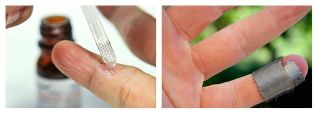
chemical treatment
Milk-salicylic collagen and salicylic patches are used to relieve warts. The percentage of medications and method of use (long-term wear of patches, applications, etc. ) depends on the prevalence and localization of the neoplasm.< / p>
Solutions of zinc and 2-chloropropionic acid can also be used. In this case, a chemical composition is applied to the pre-treatment surface, which is left on the wart until the color changes. Goes (depending on the type of wart). The procedure is repeated several times after 7, 14 and 21 days. Before each procedure, the tissue is removed mechanically.
Another chemical method is a combination of nitric, acetic, oxalic, lactic acid and copper nitrate trihydrate. In this way, only relatively small neoplasm is treated - up to 5 mm. The slurry is also left to change the color of the flesh. After 3–5 days, the patient arrives for a follow-up appointment, if necessary, he is prescribed a second procedure in 1–4 weeks.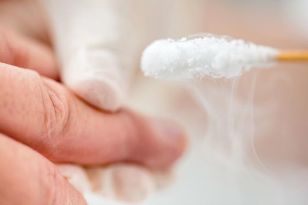
cryodestoration
This method involves freezing the wart with liquid nitrogen: a moistened damped tampon is pressed against the damaged skin (with a few mm to hold the surrounding tissue) for 1-5 minutes. Several treatments are required over the course of four weeks to destroy.
The main disadvantages of cryodestruction are its painfulness and delayed effects compared to other methods, in which only one procedure is often sufficient to remove. Is.
electrocoagulation
Under the influence of an electric current, the wart is removed in layers. The operation is performed under local anesthetic.
This method is more effective than cryodextraction, but has one important disadvantage: electrocutry often leaves behind scars at the site of wart removal. For patients who want to correct a cosmetic defect, 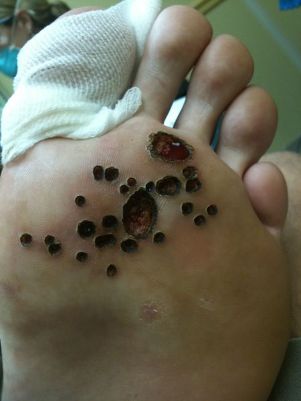 This method will not be most suitable.
This method will not be most suitable.
laser destruction
Thelaser also removes the warts in the layers. The light guide makes contact with the skin for several seconds to three minutes, depending on the size. The visible scab is then stimulated, and the lower part of the wound is again applied to the laser. Is treated. Then the patient is instructed how to handle the wound. The operation itself is done under the influence of local anesthesia.
Radioav surgery
Radio wave surgery is one of the most modern and gentle methods of removing some benign neoplasm, including warts.
Themethod is based on the generation of electromagnetic waves with different frequencies: from 100 kHz to 105 MHz. During the process, tissues resist the passing waves, which is why molecular energy is released into cells, whichHeats the skin. Under the effect of heat, the cells actually evaporate - a clean cut is achieved. At the same time, no mechanical force is applied to the affected tissue.
Pros of this method:
- security;
- acute wound healing;
- Good cosmetic effect - scars and scars are excluded;
- Relative painlessness - local anesthetic is applied before mini-surgery;
- Exclusion of secondary infection due to automatic disinfection of the electrode when the device is powered on. <> / l>
The effectiveness of this method is recognized worldwide, however, it is difficult to find a clinic that uses the method of radio wave surgery.
Which method of treatment to chooseAll of the above methods have several drawbacks:
- In the first few weeks, the operated area looks unattractive - the crust, darkening of the tissues. It should be taken into account if there are visible parts of the body (for example, on the face).
- Unpleasant odor and some degree of pain during surgery.
Furthermore, each of these methods has contraindications, which you need to know about the initial consultation with a dermatologist.
But the main disadvantage isIt has a high probability of relapses, especially if the warts were widespread, widespread. With each of these methods, doctors do not fight the root cause of the disease, but itsThe results are from todayHuman papillomavirus cannot be cured.
Therefore, therapy is directed at:
- or destruction of the neoplasm that appears at the site of virus initiation;
- to either stimulate an antiviral immune response;
- or a combination of these approaches.
often destructive methods of treatment are used. Their efficiency reaches 50–80%.< / px >
Childhood is generally not a contraindication to surgical treatment. Therefore, among themMany (including radio wave surgeries) are also used to treat warts in children. An exception is the chemical removal of warts due to the possibility of adverse reactions to the substance.
What to do after the operationIs
After any of these operations, be sure to follow your doctor's recommendations.
After removal of the tumor in any of the methods presented, the physician usually prescribes the treatment of the removal site. It is forbidden to remove "crusts" on yourself, wetting the wound. And exposes it to direct sunlight.
If the patient suffers from persistent warts, they should consult an immunologist - this may require drug therapy, which will increase immune resistance to manifestations of the human papillomavirus.
forecast. block
If the patient does not have immunodeficiency, the warts can go away on their own, but it will take several months to several years. So, in 65% of cases, the warts return independently within two years. If the wart is still in place after two years, it is recommended to remove it. It is recommended to remove several growths immediately.
Normal immunity and correctly chosen removal. With the method (depending on the size and type of wart), it is possible to remove pathogenic tissue and obtain a good cosmetic effect. With little immunity and other foregoing factors, the human papillomavirus virus remaining in the body causes.
There is no specific disease prevention. But is the infection so inevitable?
If you follow certain rules you can reduce the likelihood of the virus:
- Avoid walking barefoot in public places where there is a possibility of skin injury and virus infection (swimming pools, public showers, gyms).
- Choose quality shoes, change it frequently. Try to keep your feet dry. Heat and moisture are excellent breeding grounds for human papillomavirus.< / lix >
- To avoid periungual warts, only oneGo to a certified nail technician and make sure they use sterile equipment.
According to WHO (World Health Organization), a fourth vaccine against human papillomavirus is also highly effective for the prevention of anogenital warts. There is currently no vaccine available to prevent other types of warts.< /Px >
If you find a wart, do not try to close, bite, or pick it up yourself - that way you can contribute to inflammation and further spread of the virus along the skin. After "removal", instead of one wart in the morning, you can wake up with ten.














































































